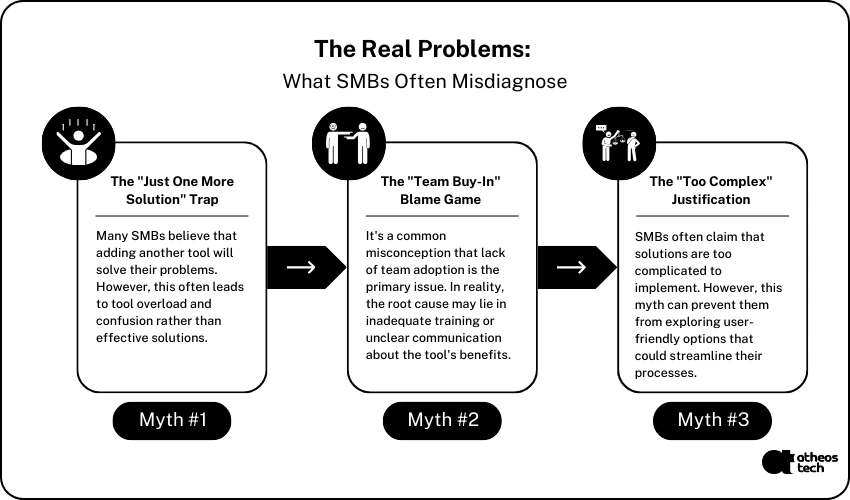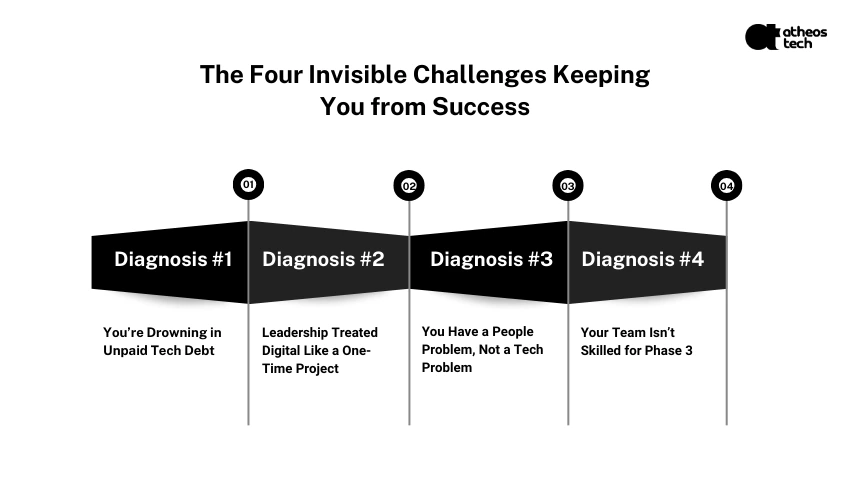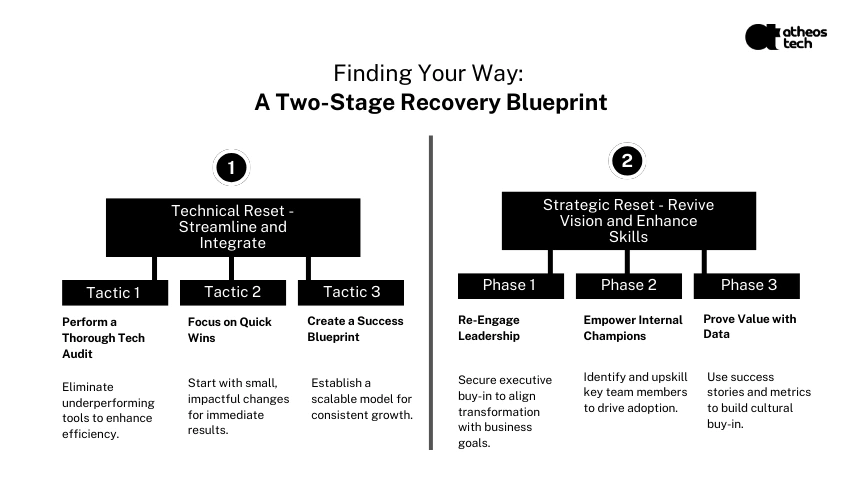
Hire UI UX Designer to Transform Your Brand Across Every Digital Channel

Congratulations.
You’ve got a CRM.
Slack is buzzing.
Your files live on Google Drive.
You’ve got three dashboards, five apps, and a team that’s “digitally enabled.”
So why does it still feel like you’re paddling in circles – even after investing in the usual small business IT solutions?
Processes are still manual.
Projects still go off the rails.
Your sales pipeline feels like it’s built with duct tape.
You’re digital, but nowhere near transformed.
Welcome to what we call the Great Digital Plateau – the frustrating no-man’s land that most small and mid-sized businesses hit after their first wave of tech adoption. You’re not analog anymore, but you’re also not truly automated, aligned, or scaling with confidence. You’re stuck in the middle.
This plateau sits squarely between Phase 2: Planning and Phase 3: Automation in our 3 Digital Phases framework. You made it past the chaos of random tools. You’ve done some strategic groundwork. But something stalled – momentum, clarity, buy-in, or all of the above.
At this stage, many SMBs start questioning themselves:
Here’s the truth: You didn’t buy the wrong tools. Your strategy stopped evolving.
This guide will diagnose the four real reasons why most SMBs get trapped on this plateau. We will expose the invisible tangle of tech debt and the deep-seated strategic issues that are secretly sabotaging your growth, and give you the framework to finally break through.
Before we uncover the real reasons you’re stuck, we have to address the common myths. Why? Because smart leaders, who are too close to the problem, often misdiagnose their own businesses. They apply the wrong solutions because they’re chasing the wrong problems.
For many leaders investing in small business IT solutions, these myths are the default explanation for poor outcomes…

This is the most common trap. You feel the friction, so your first instinct is to find a new piece of software that promises to “tie it all together.” You spend weeks researching, demoing, and finally purchasing a new app.
The Hard Truth: Adding another tool to a broken, disconnected system doesn’t create clarity. It just adds more complexity, another monthly bill, and another password for your team to forget. It’s like trying to solve a traffic jam by adding another car.
When a new system fails to deliver, the easiest person to blame is the end-user. You think, “My team just isn’t adopting the new technology fast enough,” or “They’re resistant to change.”
The Hard Truth: Your team isn’t lazy; they’re rational. People don’t resist technology; they resist friction, confusion, and systems that make their jobs harder. If adoption is low, it’s a sign the system has failed the people, not the other way around. Blaming your team is a failure of leadership, not a diagnosis of the problem.
You look at your powerful CRM or project management tool and feel overwhelmed by the sheer number of features and settings. It’s tempting to conclude that the software itself is just too complex for your business.
The Hard Truth: The problem isn’t the complexity of any single tool. It’s the fragmentation between all of your tools. The real complexity isn’t inside your CRM; it’s in the manual, 10-step process your team has to follow to get information from the CRM to your accounting software.
Let’s be clear:
These problems aren’t the disease. They’re the symptoms.
As a small business consultant, we see leaders fall into these traps every week.
You’re not suffering from a tech problem.
You’re suffering from a misalignment between systems and strategy; and that can’t be solved by another subscription.
Next, we’ll diagnose the two real forces that are actually keeping you stuck: one technical, one human.
Ready to pop the hood?
Let’s uncover what’s really holding your business back
Let’s drop the illusion: Getting “stuck” isn’t bad luck. It’s not about laziness or the wrong software. It’s a system failure – engineered unintentionally, reinforced quietly over time.
Most SMBs stall out on the path to digital maturity because of four compounding forces – two technical, two deeply human. If you’ve been stuck in Phase 2, odds are at least two of these are anchoring you down.

Let’s call them what they are:
The Problem:
Your small business IT solutions stack wasn’t designed. It was assembled. Piece by piece. Tool by tool. One SaaS subscription at a time.You chased quick wins. Added what solved the pain in the moment. But now? You’ve built a Frankenstein’s monster of disconnected systems, duplicate data, and tools that don’t talk to each other.
The Consequence:
Every new integration feels like surgery. The cost – financially and operationally – is so overwhelming, you default to doing nothing. That inertia? That’s your tech debt calling the shots.
The Problem:
After the CRM was installed and the team migrated to cloud tools, leadership declared victory. Mission accomplished. Hands dusted.
Only… digital transformation doesn’t end with implementation. It begins there.
The Consequence:
With no active oversight, no iteration, and no feedback loops, your systems went stale while your business evolved. Strategy drifted. Complexity crept in. And suddenly, the tools meant to help now feel like a burden.
That’s not bad tech – it’s strategic debt.
The Problem:
Every system in your business is only as good as its users. But when employees don’t trust, understand, or see the value in a tool, they will quietly bypass it.
Welcome to the undercurrent of cultural resistance, where “we’ve always done it this way” is silently killing your transformation.
The Consequence:
Workarounds replace workflows. Accountability blurs. Old habits take root while your digital investment collects dust. Your biggest roadblock isn’t the platform. It’s the people avoiding it.
The Problem:
Your team can use the tools. They’re great at handling individual apps. But moving from digital adoption to digital integration? That takes a different skill set.
We’re talking about APIs. Systems architecture. Data flow design. Process logic.
The Consequence:
You’ve got smart tools with no one to connect them. No automation logic. No data orchestration. Just a stack of potential that never materializes.
Your engine is built, but no one knows how to drive it.
These four forces don’t show up all at once. They sneak in quietly, one by one.
The result? You’re stuck.
But now that you see it clearly, you can start pulling the right levers.
Next: Let’s rebuild. Not from scratch – but from strategy.
So, you’re stuck. The diagnosis is in. The good news? The condition is not terminal. It is, however, systemic – and it requires a systemic solution.
The way out isn’t another tool. It’s a strategic reset. It requires a disciplined, two-pronged attack that directly addresses the technical and human forces that are holding you back.

Let’s call them what they are:
Your first move isn’t to add more; it’s to subtract. You cannot build a clean, integrated system on top of a cluttered and chaotic foundation.
Tactic 1: Ruthlessly Audit Your Tech Stack.
Get your team in a room and put every single software subscription on a whiteboard. For each one, ask the hard questions: Is this critical? Is another tool doing the same job? What would happen if we turned it off tomorrow? Your goal is to kill the clutter – the redundant, underused, and legacy small business IT solutions that are adding complexity with no real value.
Tactic 2: Start Small to Win Big.
Don’t try to boil the ocean by integrating everything at once. Instead, pick one single, high-impact workflow where the friction is most painful (e.g., Lead-to-Invoice). Your entire focus for the next 90 days is to integrate the two or three systems involved in that one process perfectly.
Tactic 3: Build a Model for Success.
When you get that first workflow humming, when data flows seamlessly from your CRM to your invoicing software without manual entry; you have achieved more than just an efficiency gain. You have created a powerful internal case study. This micro-success becomes the model and the proof that a connected system is possible, building momentum for all future integrations.
Fixing the tech is only half the battle. You must simultaneously fix the human systems that have broken down around it. These aren’t things your average IT vendor teaches. They’re the domain of elite consulting services for small businesses looking beyond the next tool.
Step 1: Leadership Re-engagement.
This is non-negotiable. The leadership team must formally shift its mindset from “the digital project is complete” to “our digital evolution is an ongoing process.” This means reallocating time, budget, and strategic focus to continuous improvement, not just maintenance.
Step 2: Identify and Upskill Your Champions.
Look within your team for the people who “get it”, the ones who are naturally curious about technology and process improvement. These are your digital champions. Invest in them. Give them formal ownership of a workflow or system. Provide targeted training not just on a tool, but on the principles of process mapping, automation, and change management. You must intentionally build the skills your business needs for Phase 3.
Step 3: Use Proof to Drive Cultural Buy-In.
Remember the successful micro-project from Part A? This is your most powerful tool for cultural change. Showcase it to the entire company. Demonstrate the hours saved, the errors eliminated, and the frustration removed. Proof beats promises every single time. When the rest of the team sees a real, tangible benefit for their colleagues, resistance begins to melt away, and a culture of improvement can finally take root
Let’s be blunt:
If you could have fixed it alone, you would’ve by now.
That’s not a knock on your leadership, it’s a truth of proximity.
When you’re deep inside the day-to-day, everything starts looking… normal.
That Frankenstein tech stack? Feels familiar.
That culture of digital avoidance? Just “how things work here.”
This is the moment most SMBs need to hear the truth:
You can’t diagnose the system while you’re living in it.
Digital transformation isn’t just about plugging in new tools.
It’s about rewiring how your business thinks, connects, and grows.
That kind of shift? It can’t be done internally alone.
Here’s what a strategic partner brings to the table:
You’ve been looking at this mess for months – or even years.
We see it with fresh eyes. No bias. No baggage. Just the truth.
And we’re not afraid to say: “This isn’t working, and here’s why.”
Most SMBs use tech like duct tape, patching problems one app at a time.
A seasoned small business consultant brings system-level thinking:
It’s not about knowing every tool.
It’s about knowing how to make them talk.
Let’s be honest – most digital plans die in Google Docs.
A real partner ensures that doesn’t happen.
We keep:
In short: we help you make good decisions, and actually implement them.
We don’t sell software.
We don’t just “implement tools.”
We diagnose, deconstruct, and rebuild. Strategically.
Unlike your average small business consultant, we don’t stop at diagnosis – we operationalize transformation.
At AtheosTech, we partner with SMBs who are “digital but stuck.”
We’ve seen the stalled momentum. The overwhelmed teams. The unused tools.
And we exist to help you do three things:
Fixing Deep Problems Requires Perspective
You can’t optimize what you haven’t diagnosed.
You can’t diagnose what you can’t see.
And you can’t see the system… from inside it.
This is your chance to change that.
From planning to automation, we’ll help you reach Phase 3
Let’s set the record straight:
Being digital is easy.
Becoming digitally mature? That’s leadership.
Most SMBs never make that leap. Most small business IT solutions are implemented without a strategic backbone, and that’s where growth silently dies.
They hit the Great Digital Plateau – tech stack bursting at the seams, growth mysteriously flat, and assume the solution is… one more tool.
It’s not.
Tools Aren’t the Problem. Alignment Is.
The plateau you’re feeling isn’t due to a lack of software.
It’s a lack of strategy. Of systems that talk. Of leadership that keeps evolving.
Digital maturity isn’t about how many tools you use.
It’s about how well they work together, and how well your people understand why.
Here’s the final insight:
“If your tech stack is full, but your growth is flat – it’s time to stop adding tools and start fixing your direction.”
Your Next Step Isn’t More Tech. It’s Coherence.
You don’t need more features. You need flow.
You don’t need more data. You need decisions.
You don’t need more automation. You need alignment.
So stop chasing tools. Start chasing traction.
Our consulting services for small businesses don’t start with a product, they start with a full-stack diagnosis.
Feeling like you’re spinning in digital circles? Let’s find your specific points of friction.
You don’t need another app. You need a diagnosis.
If small business consulting firms feel like they’re selling you tech, not clarity, let’s talk instead.
Book a complimentary 30-minute Plateau Diagnosis Call.
Adding {{itemName}} to cart
Added {{itemName}} to cart